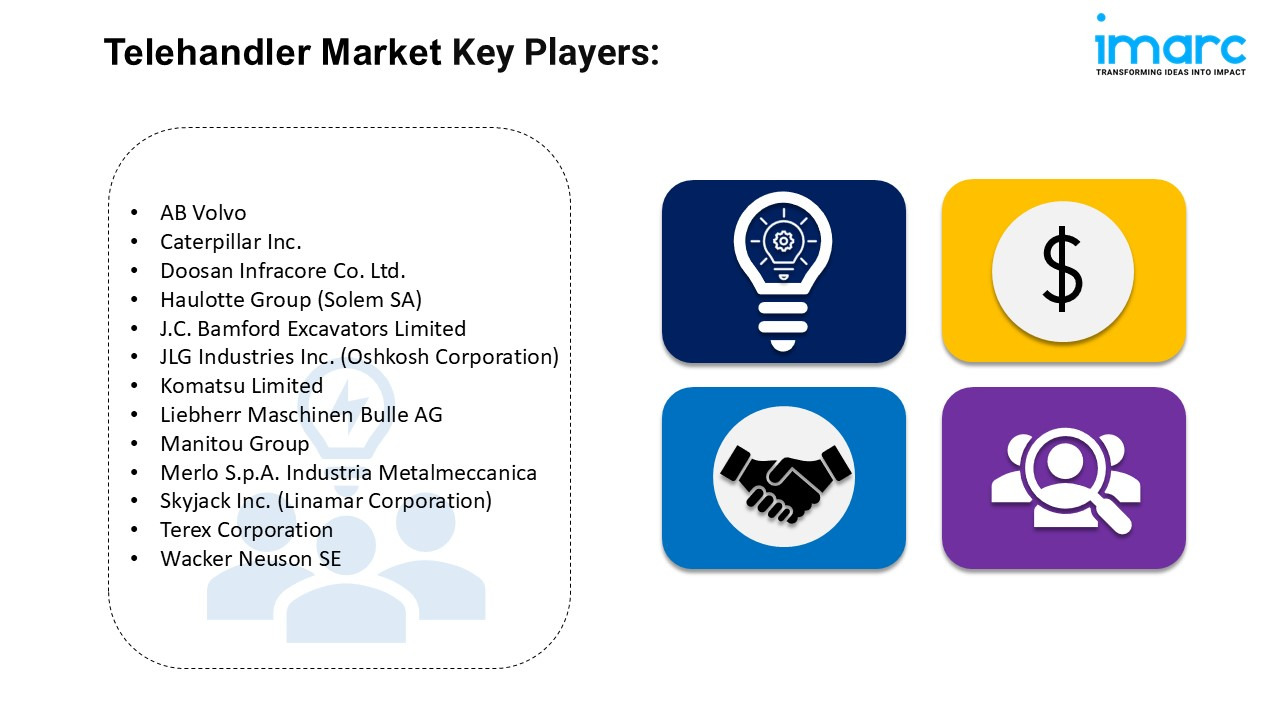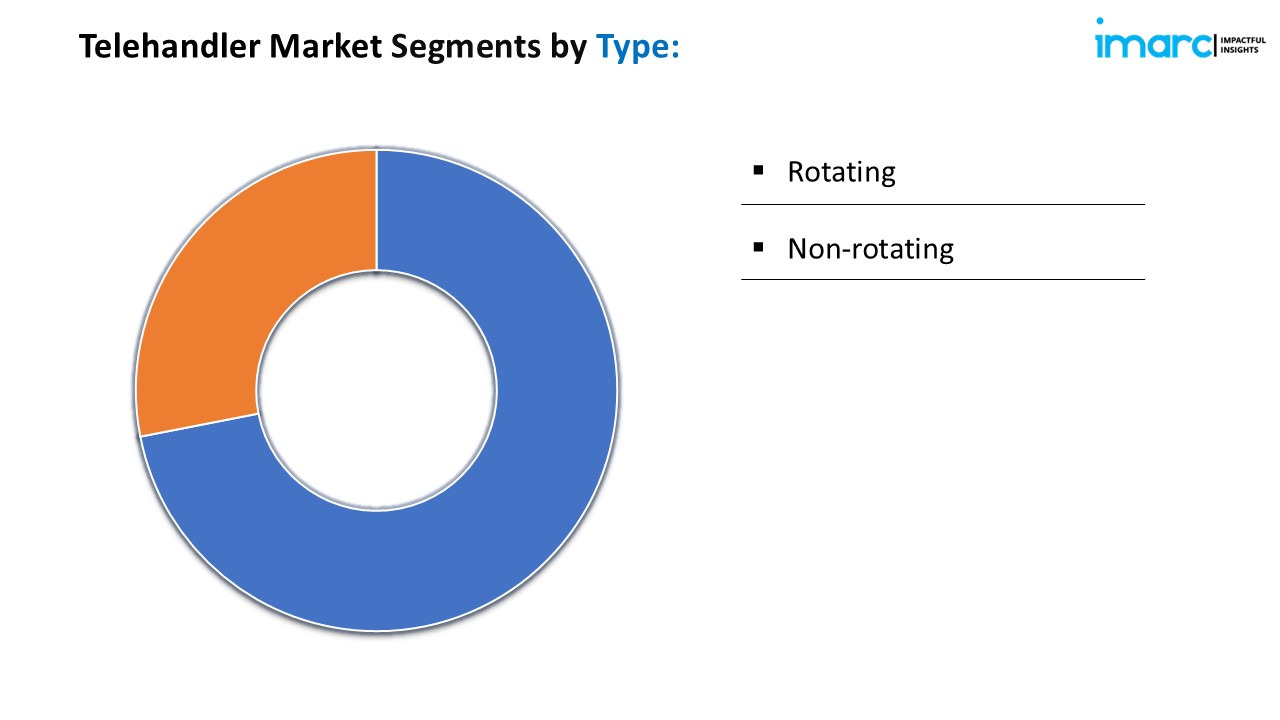Market Overview:
The telehandler market is experiencing rapid growth, driven by increasing demand in construction and infrastructure development, advancements in telehandler technology, and growth in agricultural applications. According to IMARC Group's latest research publication, "Telehandler Market Report by Product (Compact Telehandler, Large Telehandler), Type (Rotating, Non-rotating), Ownership (Rental, Personal), Height (Less Than 50 ft, 50 ft & Above), Capacity (Below 3 Tons, 3-10 Tons, Above 10 Tons), Application (Construction, Agriculture, Forestry, Mines and Quarries, and Others), and Region 2025-2033", the global telehandler market size reached USD 7.3 Billion in 2024. Looking forward, IMARC Group expects the market to reach USD 11.3 Billion by 2033, exhibiting a growth rate (CAGR) of 4.77% during 2025-2033.
This detailed analysis primarily encompasses industry size, business trends, market share, key growth factors, and regional forecasts. The report offers a comprehensive overview and integrates research findings, market assessments, and data from different sources. It also includes pivotal market dynamics like drivers and challenges, while also highlighting growth opportunities, financial insights, technological improvements, emerging trends, and innovations. Besides this, the report provides regional market evaluation, along with a competitive landscape analysis.
Download a sample PDF of this report: https://www.imarcgroup.com/telehandler-market/requestsample
Our report includes:
- Market Dynamics
- Market Trends And Market Outlook
- Competitive Analysis
- Industry Segmentation
- Strategic Recommendations
Growth Factors in the Telehandler Market
- Increasing Demand in Construction and Infrastructure Development
The telehandler market is experiencing significant growth due to the rising demand for construction and infrastructure development globally. Telehandlers, known for their versatility in lifting and moving heavy materials, are essential in large-scale projects such as commercial buildings, highways, and urban redevelopment. For instance, in rapidly urbanizing regions like Asia and Africa, governments are investing heavily in infrastructure to support growing populations. A notable example is India’s Smart Cities Mission, which has spurred demand for telehandlers to handle tasks like material transport and high-reach operations. Their ability to replace multiple machines, such as forklifts and cranes, makes them indispensable, driving market expansion as construction activities intensify.
- Advancements in Telehandler Technology
Technological innovations are a key growth factor in the telehandler market, enhancing efficiency, safety, and functionality. Modern telehandlers feature advanced telematics, improved fuel efficiency, and hybrid or electric models, catering to sustainability demands. For example, companies like JCB and Manitou have introduced telehandlers with integrated GPS and remote diagnostics, allowing operators to monitor performance in real time. These advancements reduce downtime and maintenance costs, appealing to rental companies and contractors. Additionally, attachments like rotating booms and pallet forks increase versatility, enabling telehandlers to perform diverse tasks. As industries prioritize efficiency and eco-friendly solutions, these technological upgrades continue to fuel market growth.
- Growth in Agricultural Applications
The agricultural sector’s increasing adoption of telehandlers is another significant growth driver. Telehandlers are used for tasks like stacking bales, loading grain, and transporting heavy farm equipment, offering farmers efficiency and flexibility. In regions like North America and Europe, where large-scale farming is prevalent, telehandlers have become vital. For instance, a case study from a dairy farm in Wisconsin showed that using a telehandler reduced material handling time by 30%, improving operational efficiency. The ability to equip telehandlers with specialized attachments, such as bale spikes, further enhances their utility in agriculture, driving demand as farmers seek to optimize productivity.
Key Trends in the Telehandler Market
- Rise of Rental Services
A prominent trend in the telehandler market is the growing popularity of rental services. Many businesses, especially small and medium-sized contractors, prefer renting telehandlers to avoid high upfront costs and maintenance expenses. Rental companies like United Rentals and Sunbelt Rentals have expanded their telehandler fleets to meet this demand, offering flexible leasing options. This trend is particularly evident in regions with booming construction, such as the Middle East, where short-term projects are common. Renting allows companies to access advanced models without long-term investment, making telehandlers more accessible and driving market growth through increased utilization.
- Shift Toward Electric and Hybrid Telehandlers
The shift toward electric and hybrid telehandlers is a key trend, driven by environmental regulations and the push for sustainability. These eco-friendly models reduce emissions and noise, making them ideal for urban construction sites and indoor applications. For example, Genie’s GTH-5519 electric telehandler has gained traction in Europe for its low environmental impact and ability to operate in noise-sensitive areas like hospitals. Manufacturers are investing in battery-powered systems to meet stricter emission standards, particularly in Europe and North America. This trend aligns with global sustainability goals, encouraging wider adoption of green telehandlers across industries.
- Integration of Automation and IoT
The integration of automation and Internet of Things (IoT) technologies is transforming the telehandler market. Automated features, such as load-sensing systems and remote operation, enhance precision and safety. IoT-enabled telehandlers provide real-time data on fuel consumption, load capacity, and maintenance needs, improving operational efficiency. A case study from a European construction firm demonstrated that IoT-enabled telehandlers reduced fuel costs by 15% through optimized usage. This trend is gaining momentum as industries embrace digital transformation, with manufacturers like Caterpillar incorporating smart technologies into their telehandler designs. Automation and IoT are set to redefine telehandler functionality, driving market competitiveness.
Leading Companies Operating in the Global Telehandler Industry:

- AB Volvo
- Caterpillar Inc.
- Doosan Infracore Co. Ltd.
- Haulotte Group (Solem SA)
- J.C. Bamford Excavators Limited
- JLG Industries Inc. (Oshkosh Corporation)
- Komatsu Limited
- Liebherr Maschinen Bulle AG
- Manitou Group
- Merlo S.p.A. Industria Metalmeccanica
- Skyjack Inc. (Linamar Corporation)
- Terex Corporation
- Wacker Neuson SE
Telehandler Market Report Segmentation:
By Product:
- Compact Telehandler
- Large Telehandler
Compact telehandler represents the largest market segment due to its ease of use in industrial and agricultural applications, making it ideal for tight spaces and construction projects where maneuverability is essential.
By Type:

- Rotating
- Non-rotating
The report provides a detailed analysis of the market based on these two types of telehandlers.
By Ownership:
- Rental
- Personal
The report details the market segmentation based on ownership, distinguishing between rental and personal telehandlers.
By Height:
- Less Than 50 ft
- 50 ft & Above
The report analyzes the market based on height categories, offering insights into both segments.
By Capacity:
- Below 3 Tons
- 3-10 Tons
- Above 10 Tons
The report details market segmentation based on capacity, covering all three categories.
By Application:
- Construction
- Agriculture
- Forestry
- Mines and Quarries
- Others
Construction leading the market segment, driven by increased investments in building projects globally, with telehandlers essential for moving heavy materials efficiently on construction sites.
Regional Insights:
- North America (United States, Canada)
- Asia Pacific (China, Japan, India, South Korea, Australia, Indonesia, Others)
- Europe (Germany, France, United Kingdom, Italy, Spain, Russia, Others)
- Latin America (Brazil, Mexico, Others)
- Middle East and Africa
Asia Pacific accounts for the largest market share, as detailed in the comprehensive analysis of regional markets including North America, Europe, Latin America, and the Middle East and Africa.
Research Methodology:
The report employs a comprehensive research methodology, combining primary and secondary data sources to validate findings. It includes market assessments, surveys, expert opinions, and data triangulation techniques to ensure accuracy and reliability.
Note: If you require specific details, data, or insights that are not currently included in the scope of this report, we are happy to accommodate your request. As part of our customization service, we will gather and provide the additional information you need, tailored to your specific requirements. Please let us know your exact needs, and we will ensure the report is updated accordingly to meet your expectations.
About Us:
IMARC Group is a global management consulting firm that helps the world’s most ambitious changemakers to create a lasting impact. The company provide a comprehensive suite of market entry and expansion services. IMARC offerings include thorough market assessment, feasibility studies, company incorporation assistance, factory setup support, regulatory approvals and licensing navigation, branding, marketing and sales strategies, competitive landscape and benchmarking analyses, pricing and cost research, and procurement research.
Contact Us:
IMARC Group
134 N 4th St. Brooklyn, NY 11249, USA
Email: sales@imarcgroup.com
Tel No:(D) +91 120 433 0800
United States: +1-631-791-1145

